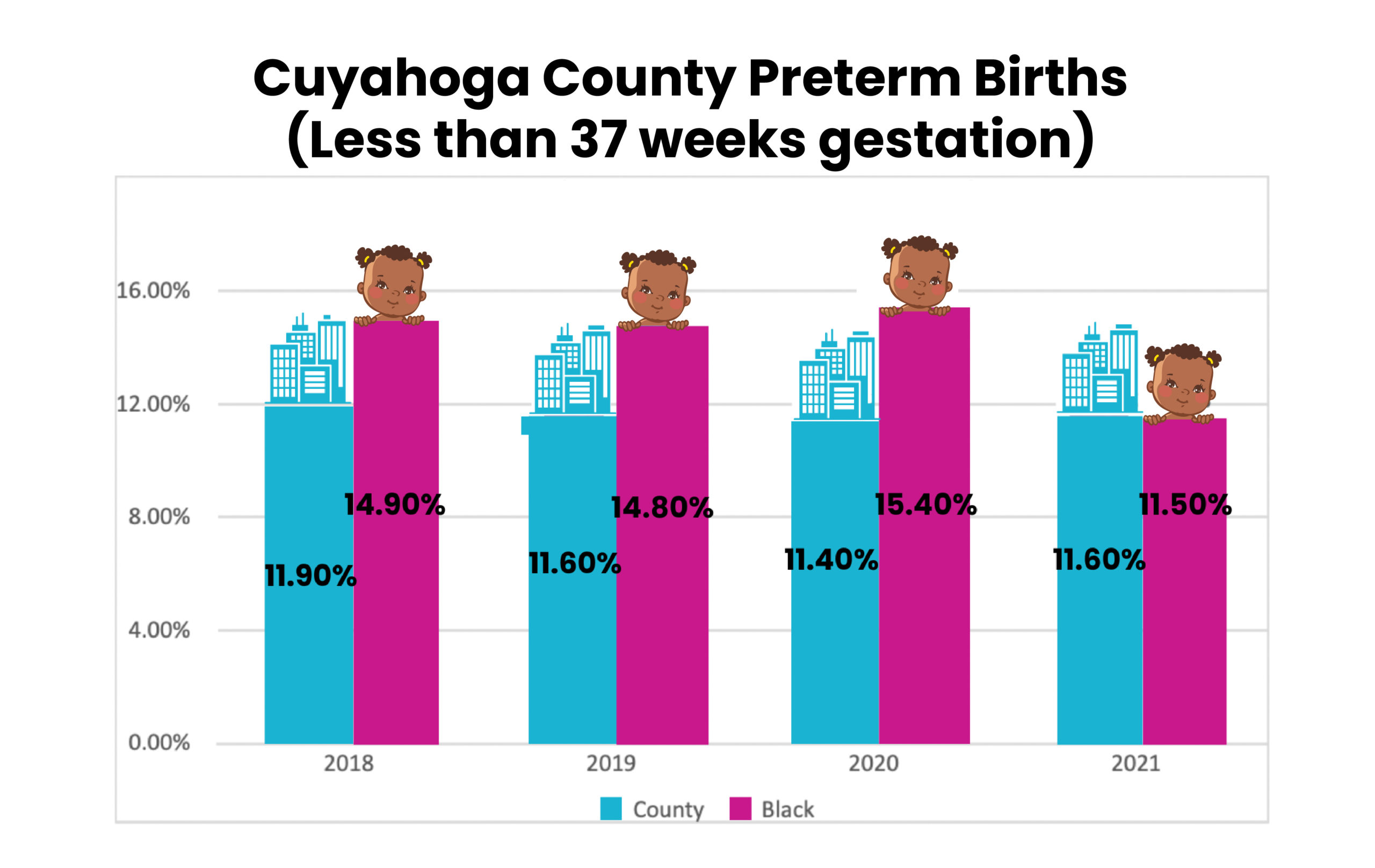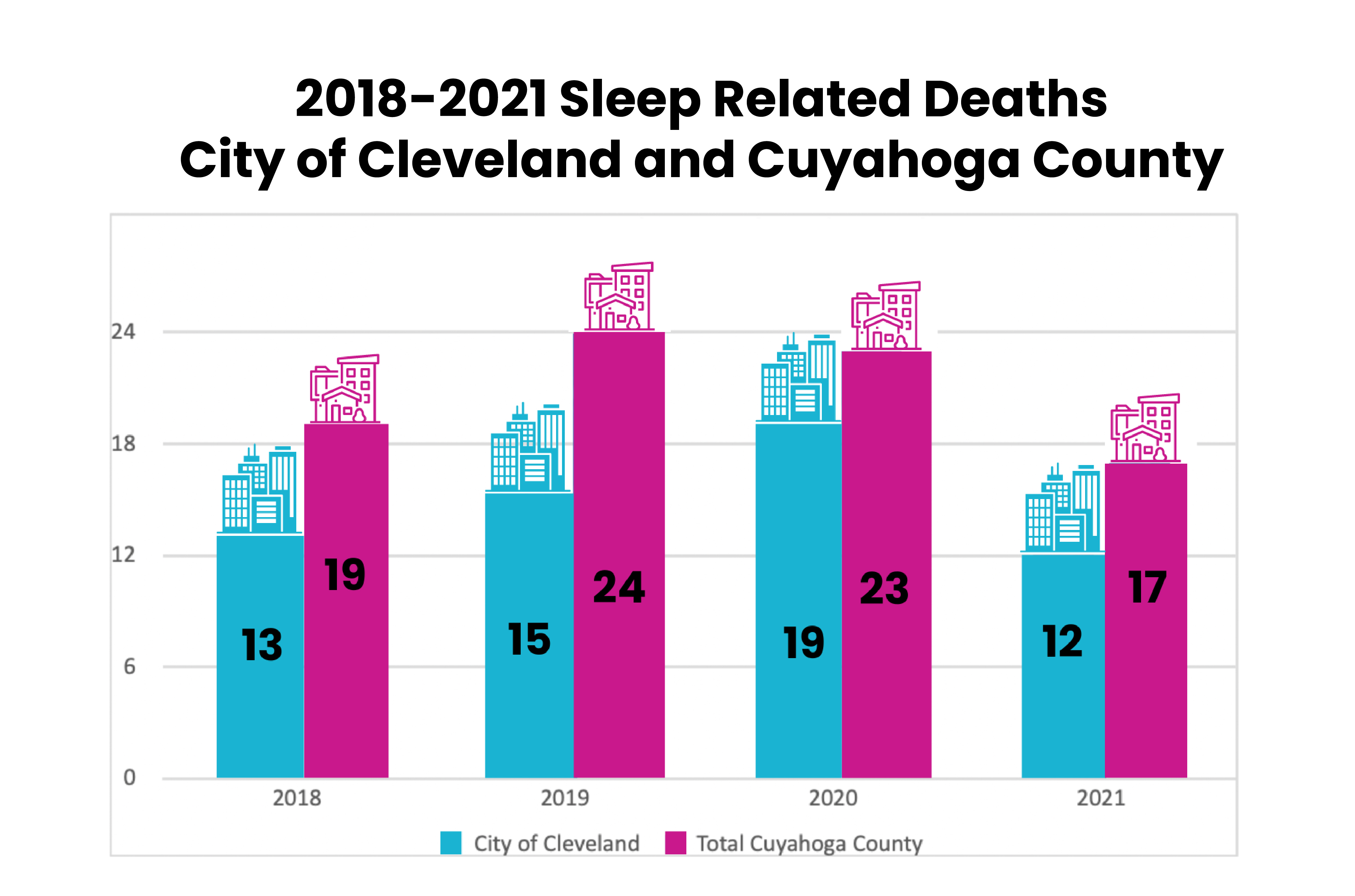Data
What is infant mortality?
Infant mortality is defined as the number of deaths in children under age one and is a key indicator of the overall health of a region. Simply stated, the higher the rates of infant mortality, the less healthy a population is overall. The infant mortality rate is the number of infant deaths per 1,000 live births.
Root causes of infant death

Prematurity
Premature birth continues to be the largest contributing factor to infant death, accounting for more than 52% of all infant deaths in 2021 (2021 Cuyahoga County Child Fatality Review).


Racial Disparities
In 2021, Black babies made up 35 percent of births in Cuyahoga County and 59 percent of infant deaths.Black mothers in Greater Cleveland are four times more likely to experience the death of their baby than white mothers, regardless of socioeconomic status.97 babies died in their first year of life in Cuyahoga County in 2021.
Check back for additional data updates and analysis.

Sleep-Related Deaths
Sleep-related deaths were the 2nd leading cause of infant deaths in 2021, tied with birth defects. Over 17% of infant deaths were sleep-related.
Infant Mortality in Cuyahoga County
For more than five decades, Cuyahoga County has had one of the highest infant death rates in the state of Ohio. In 2015, the county was the second-worst of 88 counties in Ohio. Of the 14,843 babies born in Cuyahoga County in 2015, 156 babies died before their first birthday, a 28 percent increase from 122 in 2014. The county infant mortality rate was 10.5, a 30 percent increase from 8.1 in 2014, and nearly three times the national average. Of the 13,140 babies born in Cuyahoga County in 2021, 97 didn’t make it to their first birthday. The numbers are especially concerning for Black babies.
Over the past 10 years, Cuyahoga County has shown improvement in infant mortality overall and more specifically for Black infants. The 2021 IMR for Black babies was a record low at 12.36 but still more than twice the rate of white infants at 5.24. The racial disparities we see in infant deaths are attributed to systems and structures that impact the fair and just treatment of Black communities. This is evidenced by the fact that Black women at every socioeconomic level have higher rates of infant death than white women who have not completed high school.
First Year Cleveland maintains it a priority to identify and implement key strategies that will support full-term pregnancies through an equity lens. Understanding that every family deserves to celebrate their baby’s first birthday, we must address the needs of communities and populations at greatest risk first. It will require a community that ensures equitable access to resources and conditions necessary to thrive. Thriving conditions require a commitment to address the larger policy and system issues to reflect equitable access to quality, healthcare, education, employment, (livable wages), housing, safety, and transportation.
Focusing on the “Why”
Understanding the complexity of infant and maternal mortality is vital when considering strategies that dismantle injustices and create equitable opportunities. First Year Cleveland is committed to providing research and data reports that reflect the many contributing factors of adverse health outcomes to help our partners and communities identify opportunities to support vitality.
Social Determinants of Health + Racism
Maternal and infant health is determined by more than medical care and genetics. Social determinants of health – the social, economic, and environmental factors that health outcomes – have a significant impact on infant mortality rates.
Housing, neighborhood conditions, economic security, and safety are just some of the non-clinical determinants of health outcomes that require a collaborative approach to solve. These are critical issues that must be addressed to enable mothers and children to thrive.
Data shows that there is a direct link between the root causes of health inequity (institutional racism, class oppression, and gender discrimination) and poor health outcomes.
We are dedicated to reducing racialized harm in healthcare practice and preventing future damage by improving training and education. We recognize the value of receiving care from someone who looks like the patients they serve, and we support building a diverse, trusted workforce.

